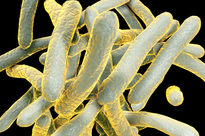 What is it? Bovine
tuberculosis is a bacterial disease caused by Mycobacterium and affects nearly
all mammals, primarily hoof stock like cattle, bison, deer, elk and goats.
Minnesota eradicated bovine TB twice, once in 1971 and again in 2005, and has
held a disease-free status since 2011. The U.S. has a strong surveillance and
response program for bovine TB and only identifies a handful of cases annually.
How is it
transmitted? Transmission is tied to close contact with an infected animal.
The disease can be spread via inhalation of infected particles when an animal
coughs or sneezes. It can also be ingested through a shared food/water source
or direct contact through an open wound. Evidence shows raw, unpasteurized,
milk can transmit TB from an infected animal to either its calf or a person
drinking the raw milk. The bacteria can survive in cool or moist conditions in
the environment, outside of an infected animal.
What are the
clinical signs? Signs can take months or years to appear. The infected
animal will start to show weakness, loss of appetite, a fluctuating fever,
increased coughing, and enlarged lymph nodes. Cattle, deer and elk typically
have a mass of tissue (granuloma) called tubercles in their head and throat
lymph nodes.
How is it
diagnosed? Because the clinical signs of bovine TB are general, diagnosis
is usually discovered at slaughter. Testing can be done on live animals with
the caudal fold tuberculin test, which involves injecting tuberculin (purified
bovine TB proteins) and looking for a skin reaction or swelling at the
injection site. Infection can be confirmed during examination of a dead animal
by testing any abnormal growths found in the animal’s lymph nodes or organs.
There is no viable treatment for infected hoof stock animals and no vaccine.
Is there a risk to
people? Yes, it is a zoonotic disease, which means people are at risk of
contracting TB from an infected animal. This risk is reduced in the U.S. by
food safety procedures like pasteurizing milk. There is a higher risk for those
working directly with cattle and those people should be vigilant for any signs
of illness in their herd.
How can it be
prevented? Bovine TB can be controlled by testing at slaughter and a strong
traceability program. This means the ability to successfully track where an
individual animal has been throughout its life so exposure to other animals and
people can be determined. Those “at risk” animals can then be segregated from
their current herd and tested for bovine TB. This is known as testing and
removal, which helps eliminate the bacteria from a population and ensure a safe
and secure food supply chain. Routine cleaning and disinfection also reduces
the chances of disease transmission.
|